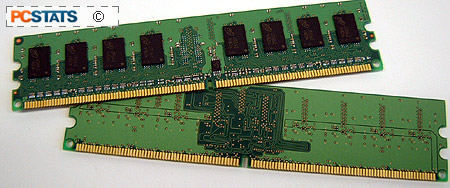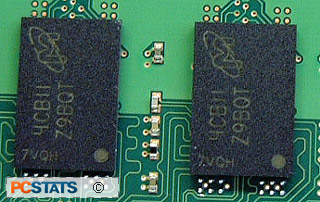Crucial PC4200 DDR-2 Memory Review
While there
are plenty of manufacturers that have DDR-2 RAM listed in their product
sheets, only a few companies are actually delivering those memory DIMMs to
consumers. Crucial.com is one
such memory manufacturer, and they are more than ready to rock and roll
with their new series of DDR-2 RAM.... after all, Micron is the parent
company of Crucial.
Considering
the technological requirements that the latest Intel Pentium 4 processor places
on the system, and very soon AMD too, retiring DDR RAM for DDR-2 was a very
necessary move. The standard DDR-SDRAM modules you have in your PC right now
simply cannot clock much higher than speeds of about 400MHz
(PC3200) without drastically increased voltages which are unacceptable to
JEDEC (the governing body for memory), or without raising memory timings to a
point which would negate any performance gain due to the higher clock speed. For
a look at memory bandwidth vs. latency timings, and the effect these factors
have on computer performance, see PCstats article here.
For these reasons, and a few
others covered in our introduction to DDR-2 article, we as consumers are going to be purchasing a
lot of memory in the next little while. As you can imagine, the choices can
be confusing with new technologies, and that is why today we are going
to be testing out a pair of Crucial PC4200 DDR-2 DIMM's which have just rolled off the production
line. Each module is 256MB in size, and the FBGA DRAM (the small back
memory chips) are rated to run with 4-4-4 memory timings, at 200 MHz, while drawing just
1.8V.

It is also worth mentioning that when these modules
first arrived in our labs, JEDEC had just changed the nomenclature for this
class from PC4300 to PC4200 DDR-2. So now, all PC4300 DDR-2 should be listed as
PC4200 DDR-2 RAM.
One of the changes brought about with DDR-2 is the
standardized adoption of FBGA DRAM modules, in place of the now retired TSOP-II
package. The FBGA package is better for higher speed memory, but it is a little
more fargile too. While DDR-2 doesn't really need any form of heatspreader,
some manufacturers are bound to apply them. And a word of warning
for everyone on that point, don't even think about removing the heatspreaders unless you're
willing to kill the DIMM! The FBGA DRAMs connect with tiny little solder balls, and
the flexing that happens when a heatspreader is removed can break those connections
quite easily.
 The label on each PC4200 DDR2
DRAM doesn't tell much about the memory, but if you go back to the manufacturers website, you can
find quite a bit about the MT8HTF3264AG-53EB3 modules used on
this Crucial DDR-2.
The label on each PC4200 DDR2
DRAM doesn't tell much about the memory, but if you go back to the manufacturers website, you can
find quite a bit about the MT8HTF3264AG-53EB3 modules used on
this Crucial DDR-2.
According to Micron, the
DRAM is rated to run with memory timings of 4-4-4 at 1.8V - which is
pretty conservative - but Crucial has always been like that. During testing, we found
that the Crucial PC4200 DDR-2 memory had no problems running with more aggressive 3-3-3 memory
timings, and without having to increase the voltage!
Of course what memory review would be complete without a section dedicated
to overclocking? ;-) Currently if you want to run a system with
DDR2, the only game in town is Intel i915p or i925x based systems.
For these tests, we plugged the Crucial DDR-2 PC4200 DIMM's into
a Gigabyte GA-8ANXP-D i925X motherboard, and enabled the 2.66x memory multiplier. Next, we began to raise
the FSB. Things were uneventful all the way up to 216 MHz, and anything higher
than that would generate a nice blank screen at POST. I believe this was the
case because the i925X test motherboard was hitting the Intel FSB lock.
It's only a
matter of time before the Taiwanese manufacturers figure a way around it, and when
they do, we'll update this review. Now, time for some DDR-2 benchmarks!

